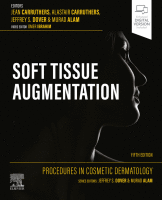Physical Address
304 North Cardinal St.
Dorchester Center, MA 02124

Summary and Key Points The majority of fillers currently used are hyaluronic acid, Poly-L-lactic acid, or calcium hydroxyapatite-based. Adverse events range between immediate, early, and late onset events. An informed consent discusses the diagnosis, nature and purpose of intervention, risks…

Summary and Key Features The increasing popularity of soft tissue augmentation requires knowledge of reversal techniques. Adverse events due to filler injection can be totally or partially reversed depending on the filler type and timing. Nonpermanent fillers are much more…

Summary and Key Features Soft tissue fillers are generally very well tolerated. However, serious vascular complications, including blindness, can occur. When filler is injected into blood vessels, ischemic or embolic phenomena may result. It is important to understand the depth…

Summary and Key Features Permanent fillers comprise mostly synthetic materials that cause collagen deposition via fibroplasia as their mechanism of action. Permanent fillers are better at facial volumizing and deep structural augmentation than at “line filling.” Silicones, polyalkylimides, polyacrylamides, polymethylmethacrylate,…

Summary and Key Features Soft tissue augmentation with temporary fillers continues to be among the most commonly performed cosmetic procedures. A large variety of temporary dermal fillers are in production, with an ever-increasing number coming to market. It is imperative…

Summary and Key Features There are a multitude of factors that contribute to skin aging, including volume loss, dyspigmentation, fine wrinkles, and changes in skin texture. A multifaceted approach targeting the various aspects of aging is often required to effectively…

Introduction There are approximately 1.4 million self-identifying transgender individuals in the United States as of the year 2016. Many of these individuals suffer from gender dysphoria, a condition of psychological distress described by the Diagnostic and Statistical Manual of Mental…

Summary and Key Features The most common techniques for filler injection include linear threading, bolus, serial puncture, fanning, and cross-hatching. A combination of techniques, as well as layering of various techniques and fillers, is often employed to address both volume…

Summary and Key Features Skin quality encompasses visual, tactile, and mechanical attributes including hydration, smoothness, elasticity, and radiance of the skin. Healthy skin is an essential component of perceived beauty. Treatment of skin quality is an important yet often-overlooked aesthetic…

Summary and Key Features The earlobe is a site of adornment and a reflection of beauty across world cultures. With increasing interest in facial and neck rejuvenation, the earlobes have emerged as a site of cosmetic concern. Like other sun-exposed…